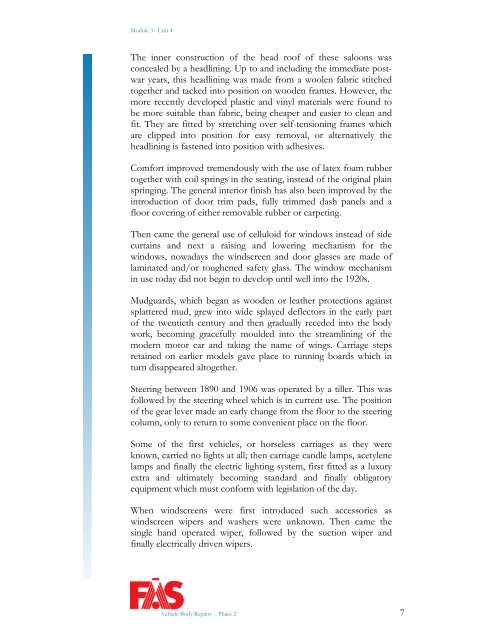TRADE OF VEHICLE BODY REPAIR - eCollege
TRADE OF VEHICLE BODY REPAIR - eCollege
TRADE OF VEHICLE BODY REPAIR - eCollege
You also want an ePaper? Increase the reach of your titles
YUMPU automatically turns print PDFs into web optimized ePapers that Google loves.
Module 3– Unit 4<br />
The inner construction of the head roof of these saloons was<br />
concealed by a headlining. Up to and including the immediate postwar<br />
years, this headlining was made from a woolen fabric stitched<br />
together and tacked into position on wooden frames. However, the<br />
more recently developed plastic and vinyl materials were found to<br />
be more suitable than fabric, being cheaper and easier to clean and<br />
fit. They are fitted by stretching over self-tensioning frames which<br />
are clipped into position for easy removal, or alternatively the<br />
headlining is fastened into position with adhesives.<br />
Comfort improved tremendously with the use of latex foam rubber<br />
together with coil springs in the seating, instead of the original plain<br />
springing. The general interior finish has also been improved by the<br />
introduction of door trim pads, fully trimmed dash panels and a<br />
floor covering of either removable rubber or carpeting.<br />
Then came the general use of celluloid for windows instead of side<br />
curtains and next a raising and lowering mechanism for the<br />
windows, nowadays the windscreen and door glasses are made of<br />
laminated and/or toughened safety glass. The window mechanism<br />
in use today did not begin to develop until well into the 1920s.<br />
Mudguards, which began as wooden or leather protections against<br />
splattered mud, grew into wide splayed deflectors in the early part<br />
of the twentieth century and then gradually receded into the body<br />
work, becoming gracefully moulded into the streamlining of the<br />
modern motor car and taking the name of wings. Carriage steps<br />
retained on earlier models gave place to running boards which in<br />
turn disappeared altogether.<br />
Steering between 1890 and 1906 was operated by a tiller. This was<br />
followed by the steering wheel which is in current use. The position<br />
of the gear lever made an early change from the floor to the steering<br />
column, only to return to some convenient place on the floor.<br />
Some of the first vehicles, or horseless carriages as they were<br />
known, carried no lights at all; then carriage candle lamps, acetylene<br />
lamps and finally the electric lighting system, first fitted as a luxury<br />
extra and ultimately becoming standard and finally obligatory<br />
equipment which must conform with legislation of the day.<br />
When windscreens were first introduced such accessories as<br />
windscreen wipers and washers were unknown. Then came the<br />
single hand operated wiper, followed by the suction wiper and<br />
finally electrically driven wipers.<br />
Vehicle Body Repairs - Phase 2 7
















